Line color
In mineralogy, the line color (short line ) describes the color of the mineral powder, which is used as a simple method of determination to distinguish between externally similar minerals .
In order to get the line color of a mineral, it is pressed against a rough, unglazed porcelain surface and then rubbed along it. The abrasion then appears in a characteristic color, which can be very different from the color of the mineral. For example, the line of the metallic golden shimmering “fool's gold” (pyrite) is black, as is that of most ores .
In the case of idiochromatic (self-colored) minerals, the line color often resembles the mineral color. In the case of allochromatic (foreign-colored) minerals, on the other hand, the line color is usually white. Colorless minerals always have a white line.
The scriber board has a Mohs hardness of 6 and thus corresponds to the hardness of orthoclase, for example . If a mineral is harder than the reticle, a small sample of the mineral can be crushed (pulverized) in a mortar and ground on the reticle. A white porcelain board is recommended for dark minerals and a black porcelain board for light minerals.
literature
- Rudolf Graubner: Lexicon of geology, minerals and rocks . Emil Vollmer Verlag, Munich 1980, ISBN 3-87876-327-1 , p. 370 .
- Walter Schumann: Precious stones and gemstones. All kinds and varieties. 1900 unique pieces . 16th revised edition. BLV Verlag, Munich 2014, ISBN 978-3-8354-1171-5 , pp. 32, 34–35 (selection list of line colors for precious and semi-precious stones).
Web links
- Mineral Atlas: Strich (Wiki)

